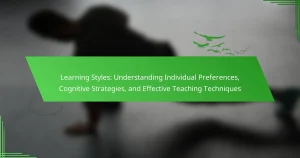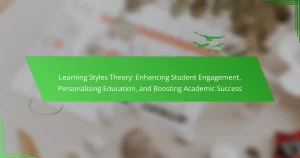Understanding educational psychology is essential for improving teaching effectiveness and student engagement. This research explores diverse learning styles, cognitive development, and effective teaching strategies. It highlights the importance of adapting instructional methods to cater to individual preferences and needs. Additionally, it discusses the implementation of learning style assessments to enhance educational outcomes.

What is the significance of educational psychology in understanding learning styles?
Educational psychology is crucial for understanding learning styles as it informs tailored teaching strategies. Recognising individual cognitive development helps educators adapt methods to enhance student engagement and retention. Research highlights that diverse learning styles, such as visual, auditory, and kinesthetic, require different instructional approaches. For instance, incorporating multimedia resources can significantly benefit visual learners, while hands-on activities are effective for kinesthetic learners. This adaptability fosters an inclusive learning environment, ultimately improving educational outcomes.
How do learning styles influence cognitive development?
Learning styles significantly influence cognitive development by tailoring educational approaches to individual preferences. Research indicates that aligning teaching strategies with students’ learning styles enhances engagement and retention. For instance, visual learners benefit from diagrams, while auditory learners thrive with discussions. These adaptations foster more effective learning environments, ultimately supporting cognitive growth. Studies show that personalised learning can lead to improved academic performance, demonstrating the importance of recognising diverse learning preferences in educational psychology.
What are the main theories of learning styles?
The main theories of learning styles include the VARK model, Gardner’s Multiple Intelligences, and Kolb’s Experiential Learning Theory. Each theory offers unique insights into how individuals process information and learn effectively.
The VARK model categorises learners into four types: Visual, Auditory, Reading/Writing, and Kinesthetic. This model emphasises the preference for specific sensory modalities in learning.
Gardner’s Multiple Intelligences theory identifies eight distinct intelligences, including Linguistic, Logical-Mathematical, and Interpersonal, suggesting that individuals excel in different areas.
Kolb’s Experiential Learning Theory focuses on the process of learning through experience, emphasising the cyclical nature of learning involving concrete experience, reflective observation, abstract conceptualisation, and active experimentation.
Understanding these theories can enhance teaching strategies and cater to diverse learning preferences.
What is Gardner’s Theory of Multiple Intelligences?
Gardner’s Theory of Multiple Intelligences posits that intelligence is not a single entity but a combination of distinct types. These intelligences include linguistic, logical-mathematical, spatial, musical, bodily-kinesthetic, interpersonal, intrapersonal, and naturalistic. Each intelligence represents a unique way individuals process information and learn. This theory emphasises the importance of recognising diverse learning styles in educational settings, promoting tailored teaching strategies that cater to individual strengths. By understanding these intelligences, educators can enhance cognitive development and improve learning outcomes.
How does Kolb’s Experiential Learning Theory apply to learning styles?
Kolb’s Experiential Learning Theory emphasises that individuals learn through experiences, which aligns with various learning styles. The theory identifies four stages: concrete experience, reflective observation, abstract conceptualisation, and active experimentation. Each learning style corresponds to a stage, helping educators tailor teaching strategies. For instance, reflective learners benefit from discussions, while active learners thrive in hands-on activities. This alignment enhances cognitive development and effective teaching strategies, ensuring diverse learning needs are met.
What are the universal characteristics of effective teaching strategies?
Effective teaching strategies share universal characteristics that enhance student learning. These include adaptability, engagement, clear communication, and assessment-driven instruction. Adaptability allows teachers to modify their approaches based on student needs. Engagement fosters active participation, which improves retention. Clear communication ensures that concepts are conveyed effectively. Assessment-driven instruction uses feedback to refine teaching methods and address learning gaps.
What role does differentiation play in teaching?
Differentiation is crucial in teaching as it addresses diverse learning needs. By tailoring instruction to individual student strengths and weaknesses, educators enhance engagement and comprehension. This approach fosters a deeper understanding of material, enabling students to achieve their full potential. Research indicates that differentiated strategies, such as varied content delivery and assessment methods, significantly improve learning outcomes across various cognitive development stages.
How can formative assessment enhance learning outcomes?
Formative assessment significantly enhances learning outcomes by providing ongoing feedback to students and teachers. This assessment type identifies individual learning needs and informs instructional adjustments. Research shows that formative assessment can lead to a 25% increase in student performance (Black & Wiliam, 1998). By utilising various methods, such as quizzes and peer reviews, educators can create a responsive learning environment that supports cognitive development. This approach fosters a deeper understanding of material, ultimately improving overall academic achievement.
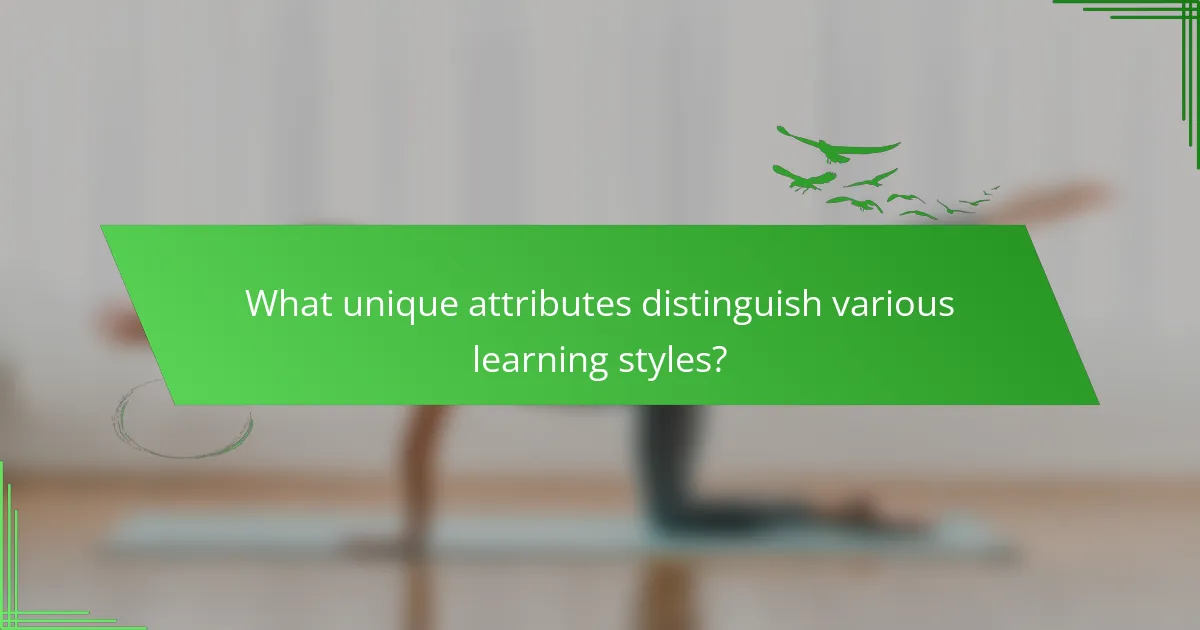
What unique attributes distinguish various learning styles?
Diverse learning styles are distinguished by unique attributes such as sensory preference, information processing, and interaction approach. For instance, visual learners prefer diagrams, while auditory learners benefit from lectures. Kinesthetic learners engage through hands-on activities, showcasing distinct cognitive engagement methods. Understanding these attributes enhances teaching strategies, tailoring them to individual needs.
How does the VARK model categorize learning preferences?
The VARK model categorises learning preferences into four distinct types: Visual, Auditory, Read/Write, and Kinesthetic. Each type represents a unique way individuals prefer to absorb and process information. Visual learners benefit from diagrams and charts, while auditory learners thrive on lectures and discussions. Read/Write learners excel with text-based input, and kinesthetic learners grasp concepts through hands-on experiences. Understanding these preferences can enhance teaching strategies and facilitate effective learning environments.
What are the implications of neurodiversity on learning styles?
Neurodiversity significantly influences learning styles by highlighting the need for tailored educational approaches. Different cognitive profiles, such as autism and ADHD, affect information processing, memory retention, and engagement. For instance, visual learners may benefit from graphic organisers, while auditory learners thrive with discussions. Understanding these variations allows educators to create inclusive strategies that enhance learning outcomes. Research shows that personalised teaching methods increase student satisfaction and achievement, emphasising the value of neurodiverse perspectives in educational psychology.
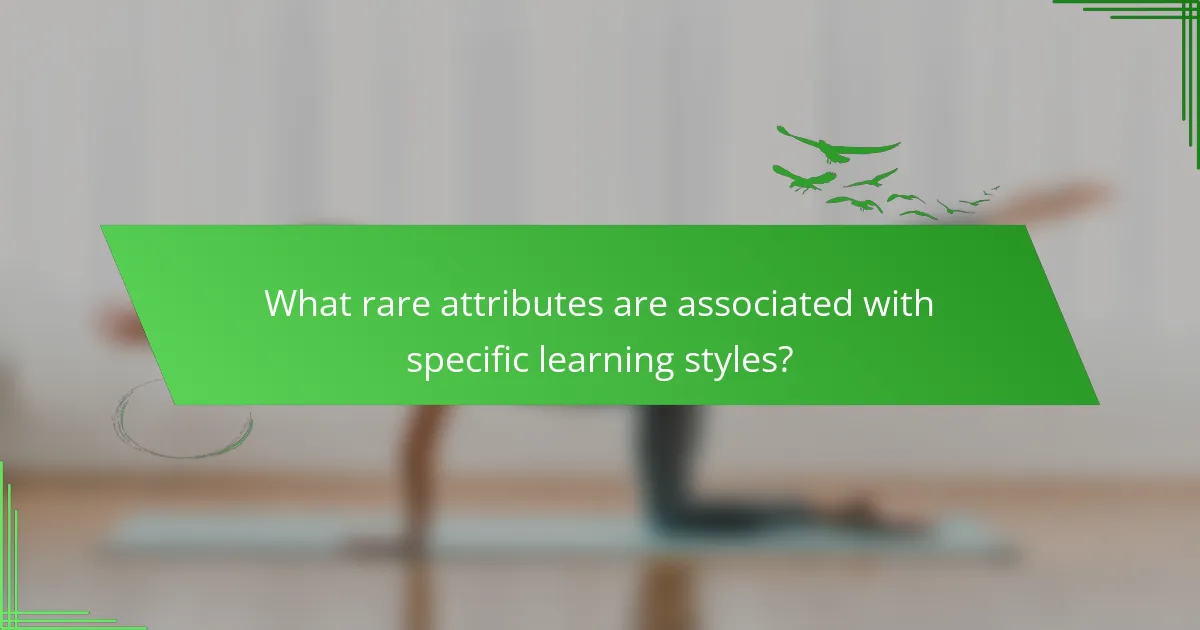
What rare attributes are associated with specific learning styles?
Certain rare attributes linked to specific learning styles include adaptability, emotional intelligence, and self-regulation. Adaptability allows learners to modify their approaches based on context. Emotional intelligence enhances interpersonal skills and motivation in collaborative environments. Self-regulation fosters independent learning and goal-setting capabilities. These attributes contribute to a deeper understanding of cognitive development and effective teaching strategies.
How do cultural factors influence learning preferences?
Cultural factors significantly shape learning preferences by influencing motivation, communication styles, and cognitive approaches. Different cultures prioritise various learning methods, affecting how individuals engage with educational content. For instance, collectivist cultures often emphasise group learning and collaboration, while individualistic cultures may favour independent study. Understanding these cultural nuances allows educators to tailor teaching strategies effectively, enhancing student engagement and retention. Research indicates that culturally responsive teaching can lead to improved academic outcomes by aligning educational practices with students’ cultural contexts.
What are the challenges faced by educators in accommodating diverse learning styles?
Educators face significant challenges in accommodating diverse learning styles, including varying student needs, limited resources, and insufficient training. These factors hinder effective teaching and learning outcomes.
One primary challenge is recognising the unique attributes of each learning style, which can vary widely among students. For example, some learners may excel with visual aids, while others benefit from hands-on activities. This diversity complicates lesson planning and classroom management.
Additionally, educators often encounter constraints in resources, such as access to varied teaching materials and technologies that support differentiated instruction. Without these tools, it becomes difficult to meet the diverse needs of all students.
Lastly, many educators report a lack of training in effectively implementing strategies that cater to different learning styles. This gap in professional development can lead to ineffective teaching methods that do not engage all students, ultimately impacting their cognitive development and academic success.
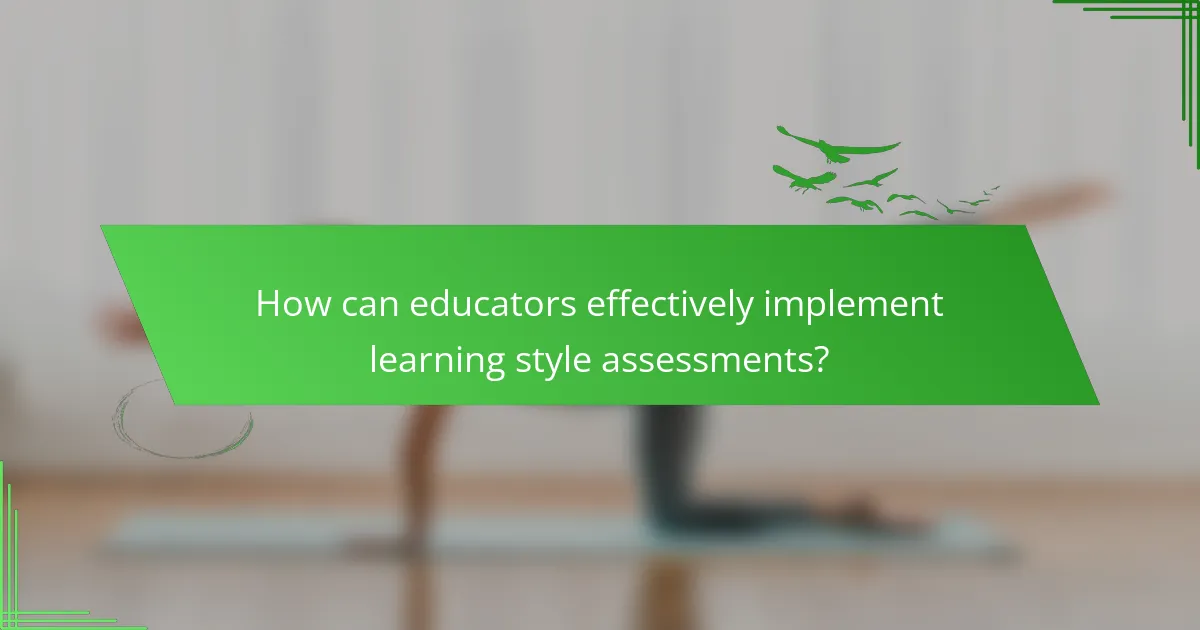
How can educators effectively implement learning style assessments?
Educators can effectively implement learning style assessments by integrating diverse assessment tools and adapting teaching strategies accordingly. Utilise surveys and quizzes to identify students’ preferred learning styles. Analyse results to tailor instructional methods, ensuring a mix of visual, auditory, and kinesthetic approaches. Regularly reassess learning styles to accommodate changes in students’ preferences. Collaborate with colleagues to share insights and strategies for enhancing engagement based on assessment outcomes.
What practical tools are available for identifying learning styles?
Various practical tools exist for identifying learning styles, including assessments, questionnaires, and observation methods. Popular assessments like the VARK questionnaire categorise learners into visual, auditory, reading/writing, and kinesthetic styles. Additionally, tools such as the Learning Style Inventory and Howard Gardner’s Multiple Intelligences framework provide insights into individual preferences. Observational methods involve teachers assessing student engagement and participation to tailor instruction. These tools enhance educational strategies by aligning teaching methods with identified learning styles, improving cognitive development.
What best practices can enhance teaching strategies based on learning styles?
To enhance teaching strategies based on learning styles, educators should employ diverse instructional methods. Incorporating visual aids, hands-on activities, and group discussions caters to various learning preferences. Additionally, regular assessments can inform adjustments in teaching approaches. Research indicates that adaptive teaching improves cognitive development and student engagement. Implementing these strategies fosters a more inclusive learning environment.
What common mistakes should educators avoid when applying learning styles?
Educators should avoid overgeneralising learning styles, neglecting individual differences, and relying solely on one method. Misapplying learning styles can hinder cognitive development and limit effective teaching strategies. Emphasising a single style overlooks the complexity of student needs. Additionally, failing to assess the impact of varied strategies can lead to ineffective learning outcomes. Engaging in continuous evaluation and adapting methods is crucial for fostering an inclusive learning environment.
What are the future trends in educational psychology and learning styles?
Future trends in educational psychology emphasise personalised learning, integrating technology, and understanding diverse learning styles. Research indicates a shift towards adaptive learning environments that cater to individual cognitive development. Collaborative learning and social-emotional learning are gaining traction, enhancing engagement and retention. Additionally, data analytics will shape effective teaching strategies, allowing educators to tailor approaches based on real-time feedback.

